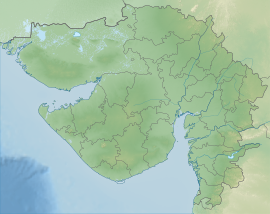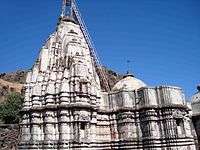Pavagadh Hill
Pavagadh Hill is situated within a plain in Panchmahal district, Gujarat, western India. A volcanic eruption occurred in the region approximately 500 million years ago and the etymology of Pavagadh is associated with this eruption: Pav-gadh means "one fourth hill" or "fire-hill". At its base is the historical city of Champaner, while the hill station of Pavagadh was built upon the volcanic cone itself. With Champaner, Pavagadh hill forms the Champaner-Pavagadh Archaeological Park, a UNESCO World Heritage Site which is spread over an area of more than 1,329 hectares (3,280 acres).[1] Known for its forts, there are also dozens of heritage structures on the hill.[2] The site is 50 kilometres (31 mi) east of Vadodara and 68 kilometres (42 mi) south of Godhra.
| Pavagadh Hill | |
|---|---|
Summit of Pavagadh Hill with the famed Kalika Mata Temple shrine on the peak | |
| Highest point | |
| Elevation | 800 m (2,600 ft) |
| Coordinates | 22°28′00″N 73°30′02″E |
| Geography | |
 Pavagadh Hill Panchmahal district, Gujarat, western India | |
| Parent range | Vindhyachal Range |
| Geology | |
| Mountain type | Hill |
| Last eruption | 65 million years ago |
| Climbing | |
| Easiest route | Ropeway |
Faith based legend surrounding Pavagadh formation suggests that the right foot of Sati is believed to have fallen at Pavagadh, thus forming a deep valley and the God later on "sent a large hill as per the request of Rishi Vishwamitra to fill up this deep valley so that the sage's sacred cows do not fall into it." Thus Kalika Mata Temple at Pavagadh is one of the holiest of Shaktipeets in Indian subcontinent."[3][4]
Geography
The hill is a southern Aravalli Range outlier, rising 800 metres (2,600 ft) above the surrounding plains.[4] The Dhadhar River and Vishwamitri River originate on the hill.[5] The Surya stream, which also rises on the hill, joins the Vishvamitri.[6] There are five successive plateaus, Kalikamata Plateau, Mauliya Plateau, Bhadrakali Plateau, Machi Plateau and Atak Plateau.[7] Plateau reservoirs (talaos) form a chain up the hill. Other features include dense forest, reddish-orange rhyolite boulders, and a natural cave just below the summit. Strong monsoon breezes blow winds upwards onto steep hill slopes.[4]
The arrangement of the rock formations of Pavagadh Hill is stated as being "rhyolite, green bedded tuffs, porphyritic basalt, olivine dolerite and nonporphyritic alkaline basalt."[8] There are steep rock exposures whose geological formation is attributed to ancient volcanic eruptions and lava flows. Pavagadh Hill has a geological setting of reddish-yellow coloured stone, and is considered to be one of the oldest rock formations in India.[1][9][10][11]
The geological formation of Pavagadh Hill is thus very complex. It is interpreted as part of the Deccan Traps, which arose from the "tumultuous outpour of lava beyond 106 cubic km in volume. Eruption is deduced to have occurred 69-65 Ma age. These basaltic rocks said to be one of the largest continental flood basaltic provinces in the world." Studies carried by geologists have indicated eleven basic flows superposed by felsic volcanics. New varieties of rocks such as "rhyodycite, alkal-olivine basalt, mugearite and ankaramite" are reported. It is also recorded that except for rhyolite, all the rocks have an "alkaline-oloivine lineage." Geologists have also observed that "seventeen horizontal flows have occurred in Pavagadh and postulated that the "whole series resulted by fractionalism in two episodes."[12]
The highest point of the hill presents an undulating forested topography in the direction of Jambughoda. The path ascending the hill passes through many old gates and cuts through natural ledges of rock like a staircase, with precipitous sides. Midway up this path is a flat ground which is strewn with boulders. The mountain above the flat ground is a very steep hill scarp.[13]
Transportation
While private vehicles are not allowed, registered buses and government vehicles provide transportation up the hill. As the road ends before reaching the summit, there are only two options to reach the top, either on foot or by ropeway.[14] The mono-cable ropeway is 740 metres (2,430 ft) in length. It can carry 1,200 people per hour. It is stated to be the country's highest ropeway, connecting the summit of the hill with the plateaus of Champaner.[15]
History and legends
Human settlement occurred around the second century after the hill became associated with the goddess Kali. It is believed that the foot of Parvati fell on this hill, making it sacred.[16] Legend states that the hill's formation is attributed to the sage Vishwamitra Rishi, who lived here in bygone days. He had a cow named Kamadhenu. One day, the cow slipped while grazing and fell into the valley, which resulted in the cow attempting to scramble up the hill. Finally she produced milk, which filled the valley, and swam to higher ground. The Rishi came to know of this mishap, and in order to prevent any such incident in the future, he prayed to the gods to fill the valley. The gods fulfilled his prayers with one fourth of a hill projecting out of the plains, Pavagadh Hill.[17]
Known for its forts, there are also dozens of heritage structures on the hill.[2] It is part of the Champaner-Pavagadh Archaeological Park, a UNESCO World Heritage Site.[1][11][18]
Jain Temple

The temples of Jainism at Pavagadh are also noteworthy. They are of three groups: The first consists of the Bhavanaderi temples near the Naqqarkhana gate called the Navalakka temples, the second group is in honour of the tirthankaras Suparshvanatha and Chandraprabhu and the third group, situated on the south east of Pavagarh Hill (Mataji's cliff), is near the Pārśva temple next to the Dudhia tank. On the basis of their "stylistic and architectural features", the date of construction of these temples is deduced to be the 14th–15th centuries. The temple is made up of pure white stone with elaborately carved seated and standing images of the Jain pantheon are seen on the outer walls of the temples. The Garbabrihas are enshrined with beautiful stone images of tirthankaras in these temples. All the temples have been renovated over time.[19] The temple also has a 30 ft. tall statue of God Bahubali stands tall in its vicinity.[20]
The Greek geographer Tolemi, who visited India in 140 A.D. regarded this temple as an ancient and holy place. In 1480 Mohammed Begdo, the Muslim sultan, heavily impaired this temple. In 1880 this temple was repaired. The entire complex houses a Dharmshala or guesthouse, a Jain restaurant and gardens.[21]
References
- "Champaner-Pavagadh Archaeological Park". United Nations Educational, Scientific and Cultural Organization. Retrieved 24 September 2012.
- Ruggles, D. Fairchild; Silverman, Helaine (15 June 2009). Intangible Heritage Embodied. Springer. pp. 84–. ISBN 978-1-4419-0071-5. Retrieved 29 September 2012.
- Burman, J. J. Roy (2005). Gujarat Unknown: Hindu-Muslim Syncretism and Humanistic Forays. Mittal Publications. p. 79. ISBN 978-81-8324-052-9. Retrieved 29 September 2012.
- Silverman, Helaine; Ruggles, D. Fairchild (14 October 2008). Cultural Heritage and Human Rights. Springer. pp. 55–. ISBN 978-0-387-76579-2. Retrieved 29 September 2012.
- "Dhadhar River". guj-nwrws.gujarat.gov.in, Government of Gujarat. Retrieved 29 September 2012.
- Gujarat (India: state) (1979). Gujarat State Gazetteers: Vadodara. Directorate of Government Printing, Stationery and Publications, Gujarat State. p. 12. Retrieved 29 September 2012.
- "World Heritage Scanned Nomination". Excerpt from the Report of the 28th Session of the World Heritage Committee, UNESCO. Heritage Trust. January 2002. p. 21. Retrieved 30 September 2012.
- Chavan, Appasaheb Ramachandrarao; Oza, G. M. (1966). The flora of Pavagadh, Gujarat State, India. Dept. of Botany, Faculty of Science, M. S. University of Baroda. Retrieved 29 September 2012.
- "Advisory Body Evaluation, Champaner-Pavagadh (India) No 1101" (pdf). United Nations Educational, Scientific and Cultural Organization. pp. 26–29. Retrieved 24 September 2012.
- "United Nations Educational, Scientific and Cultural Organization (UNESCO) Fact Sheet". United Nations Educational, Scientific and Cultural Organization. Retrieved 24 September 2012.
- "Champaner-Pavagarh Archaeological Park (2005), Gujarat". National InformaticCentre (NIC) for Arechaeological Survey of India (ISI). Archived from the original on 2012-05-01. Retrieved 24 September 2012.
- K.R.Hari, M.Santosh & Furuyama Katsuhiko (March 2000). "Melt inclusions in pyroxene and plagioclase phenocrysts from Pavagadh igneous suite, Gujarat, India". Journal of Geosciences. Osaka State University. 43 (7): 135–148. Retrieved 1 October 2011.
- "Champaner, near Baroda, India. Febr. 1879". Online Gallery, British Library, UK. Retrieved 29 September 2012.
- Kumar, Arjun (November 24, 2011). "The mosques and monuments of Champaner-Pavagarh". The Economic Times. Retrieved 30 September 2012.
- Limca Book of Records. Bisleri Beverages Ltd. 1990. Retrieved 28 September 2012.
- Sajnani, (India : State) (2003). Encyclopaedia of Tourism Resources in India, Volume2. Gyan Publishing House. p. 101. ISBN 9788178350189. Retrieved 28 September 2012.
- Bombay, Manohar (1887). Volume 3 of Gazetteer of the Bombay Presidency, Bombay (India :State). Printed at the Government Central Press. pp. 304–309. Retrieved 23 September 2012.
- Ruggles, D. Fairchild; Silverman, Helaine (2009). Intangible Heritage Embodied. Springer. pp. 79-. ISBN 9781441900715. Retrieved 10 October 2012.
- B. Busa Goud. "Scientific Conservation of World Heritage Monuments of Champaner-Pavgadh" (pdf). UNESCO. Org. Retrieved 29 September 2012.
- http://champaner-pavagadh.blogspot.in/2008/08/shwetamber-jain-temple.html
- http://www.jinalaya.com/gujarat/pavagadh.htm